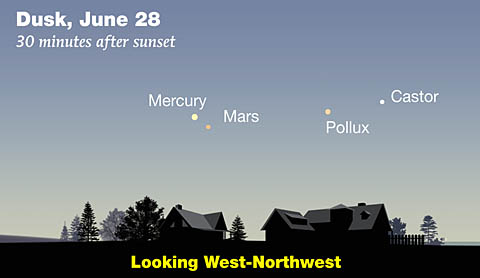Download June's Sky Tour astronomy podcast for a guided exploration of the planets, stars, and constellations in the evening skies of early summer.
LISTEN HERE:
Podcast: Play in new window | Download
Subscribe: Apple Podcasts | Google Podcasts | Spotify | Email | RSS | More
This month's Sky Tour starts with a solstice update and a rundown of lunar phases, then helps you find four planets in the evening sky along with the best stars and constellations of early summer.
For those in the Northern Hemisphere, June offers the shortest nights of the year. This month’s solstice occurs on June 21st at 11:54 a.m. EDT. Astronomically speaking, that’s when summer begins in the Northern Hemisphere and winter in the Southern Hemisphere.
Once again the lunar phases track the calendar closely. New Moon comes on June 3rd, first quarter on June 10th, and full Moon on the 17th. Traditionally, this is called the Full “Strawberry” Moon, signaling when these tasty treats get ripe. But many Europeans know it as the full Rose Moon. Last quarter follows on June 25th, and a week later the cycle starts again. Each lunation, from new Moon to new Moon, takes 29½ days — so it's no wonder our words month and Moon sound alike!

Sky & Telescope
With care you can spot four planets in the evening sky, though Mercury and Mars are hard to spot low in the west soon after sunset. Our Sky Tour podcast guides you to their locations. Then, after it gets good and dark, Jupiter, the King of Planets, rises in the east and is unmistakable.
On June 10th Jupiter reaches what’s called opposition. By then it’ll be opposite the Sun in the sky, rising at sunset, staying up all night, and setting at sunrise. It’s also when Jupiter will be closest to us and therefor its brightest. Saturn rises into the late-evening darkness about 2 hours later.
Once evening’s twilight has faded away, the Sky Tour tells you how to find Virgo, the Maiden, and Scorpius, the celestial Scorpion, along with the lesser-known constellations Corvus, the Crow, and Libra, the Scales. Long ago, skywatchers considered Libra to be part of Scorpius. Its brightest stars are Zubeneschamali (meaning “northern claw” in Arabic) and Zubenelgenubi (“southern claw”).
To find out where and when to spot all these sky sights and many more, play or download this month's episode.
 1
1
Comments
Bob
June 2, 2019 at 10:27 am
Kelly, thanks again for all you do.
You must be logged in to post a comment.
You must be logged in to post a comment.